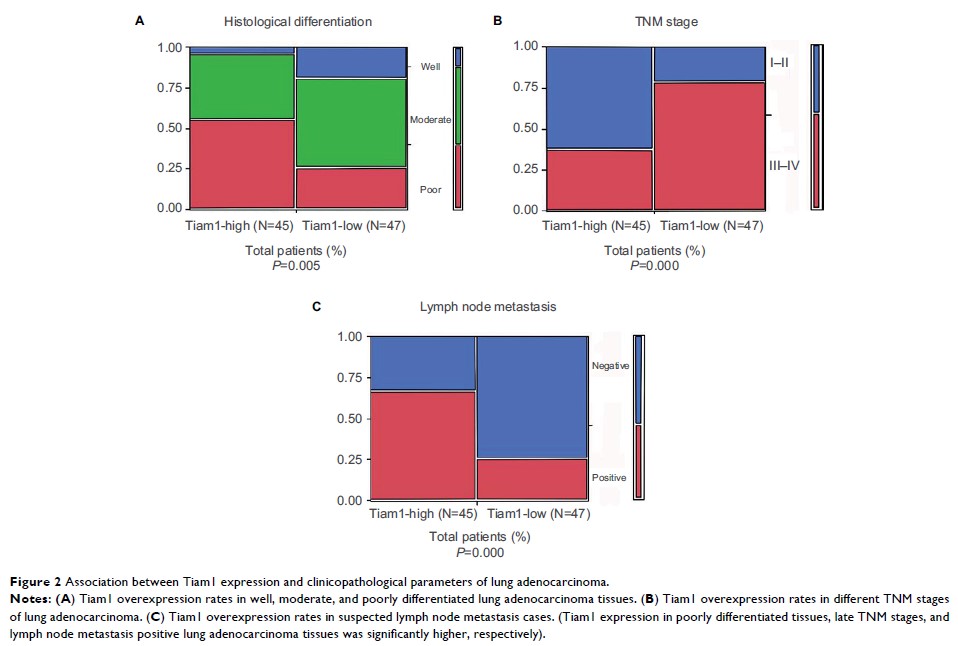108605
论文已发表
注册即可获取德孚的最新动态
IF 收录期刊
- 3.4 Breast Cancer (Dove Med Press)
- 3.2 Clin Epidemiol
- 2.6 Cancer Manag Res
- 2.9 Infect Drug Resist
- 3.7 Clin Interv Aging
- 5.1 Drug Des Dev Ther
- 3.1 Int J Chronic Obstr
- 6.6 Int J Nanomed
- 2.6 Int J Women's Health
- 2.9 Neuropsych Dis Treat
- 2.8 OncoTargets Ther
- 2.0 Patient Prefer Adher
- 2.2 Ther Clin Risk Manag
- 2.5 J Pain Res
- 3.0 Diabet Metab Synd Ob
- 3.2 Psychol Res Behav Ma
- 3.4 Nat Sci Sleep
- 1.8 Pharmgenomics Pers Med
- 2.0 Risk Manag Healthc Policy
- 4.1 J Inflamm Res
- 2.0 Int J Gen Med
- 3.4 J Hepatocell Carcinoma
- 3.0 J Asthma Allergy
- 2.2 Clin Cosmet Investig Dermatol
- 2.4 J Multidiscip Healthc

Tiam1 的预后价值与其在肺腺癌上皮间质转化进展和血管生成中的作用相关
Authors Zhu G, Zhang Y, Wang Q, Che S, Yang Y, Chen L, Lin Z
Received 18 November 2018
Accepted for publication 21 January 2019
Published 21 February 2019 Volume 2019:11 Pages 1741—1752
DOI https://doi.org/10.2147/CMAR.S195093
Checked for plagiarism Yes
Review by Single-blind
Peer reviewers approved by Dr Justinn Cochran
Peer reviewer comments 2
Editor who approved publication: Dr Kenan Onel
Background: Tiam1 has been identified as an oncogene
and acts as an activator of GTPase Rac. Tiam1 was reported to be a promoter of
cancer progression in various cancer types, while in lung adenocarcinoma, its
mechanism of action is poorly understood.
Materials and Methods: Immunohistochemistry staining and Western blot assay were used to
determine Tiam1 expression in lung adenocarcinoma tissues, and its association
with prognosis was determined by statistical analysis. We depleted Tiam1 in
both A549 and H1975 cancer cell lines. Carboxyfluorescein diacetate
succinimidyl ester staining and colony formation assays were used to evaluate
its impact on cell proliferation ability after depletion. Transwell migration
assay and wound healing assays were performed to determine its impact on
migration ability of both cell lines. Western blot assay and immunofluorescence
staining were used to analyze the association between Tiam1 and
epithelial–mesenchymal transition (EMT) progression. Tube formation assay and
vasculogenic mimicry assay were used to show the impact of Tiam1 depletion on
cancer angiogenesis.
Results: In
this study, we demonstrated that Tiam1 overexpression in lung adenocarcinoma
was significantly associated with advanced tumor grade and poor prognosis. In
vitro assays indicated that Tiam1 depletion significantly inhibited cell
proliferation, colony formation, and migration capacities in A549 and H1975
cells. Further investigations revealed that Tiam1 plays an important role in
EMT program enhancement, angiogenesis, and accelerated tumor progression.
Notably, Tiam1 depletion in cancer cells strongly inhibited human umbilical
vein endothelial cell angiogenesis and vasculogenic mimicry capacities of both
cancer cell lines.
Conclusion: Tiam1
overexpression is associated with lung adenocarcinoma progression and may
indicate poor prognosis. Tiam1 accelerated tumor progression due to EMT and
angiogenesis enhancement. Our data may provide a novel therapeutic target for
lung adenocarcinoma.
Keywords: Tiam1,
prognostic value, EMT, angiogenesis, VM, lung adenocarcinoma
